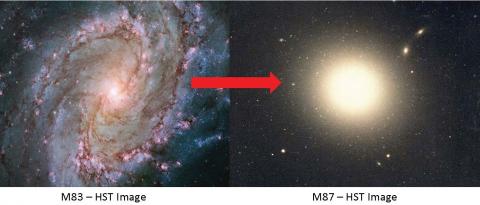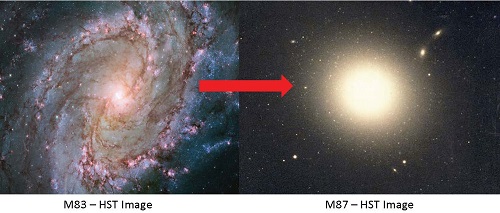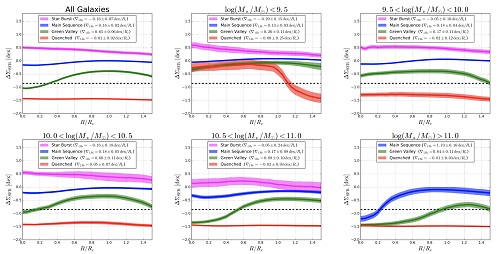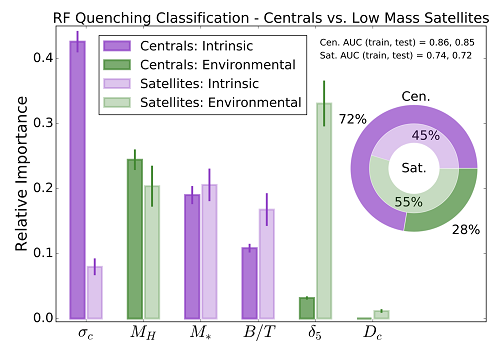
Submitted by Administrator on Wed, 16/09/2020 - 09:20
In a new study led by researchers at the Kavli Institute for Cosmology in Cambridge, evidence has been discovered for two distinct pathways for galaxies in the local universe to quench (that is, transition from a star forming to non-star forming state).
In the local Universe galaxies are observed to come in two distinct types: 1) actively star forming systems, which are often blue in appearance and disk-like in structure (like M83); and 2) non-star forming ‘quenched’ systems, which are often red in appearance and elliptical in structure (like M87).

Using spatially resolved optical spectroscopy from the MaNGA Survey the level of star formation at different locations within thousands of distant galaxies was measured. At high masses, galaxies were found to quench 'inside-out', such that the cores of these galaxies stop forming stars first. Alternatively, low mass galaxies were found to quench 'outside-in', with the outskirts of these galaxies first shutting off star formation (see Fig. 1).
Fig. 1 The relative level of star formation within galaxies plot as a function of galaxy radius for all galaxies (top left) and for increasing ranges in galaxy stellar mass (from left to right, top to bottom). Within each mass range, the star formation profiles are shown for galaxies with enhanced levels of star formation (star bursts, shown in magenta), normal levels of star formation (main sequence, shown in blue), reduced star formation (green valley, shown in green), and dramatically reduced star formation (quenched, shown in red). At low masses, galaxies in transition have star forming centres but quenched outskirts; whereas at high masses this is reversed and galaxies have quenched centres but star forming outskirts.
Additionally, the Cambridge researchers tested which physical parameters are most connected to the quenching of star formation using a machine learning technique called a ‘Random Forest’. For high mass galaxies, the most predictive parameter governing quenching was found to be the velocity with which stars orbit in the central-most regions within galaxies (see Fig. 2). Intriguingly, this parameter is well known to correlate very strongly with the mass of the central supermassive black hole in the core of galaxies. As such, the study concludes by noting a plausible connection between massive galaxy quenching and feedback from accretion of material onto the central black hole.
For low mass galaxies, the most important parameter governing the transition from an actively star forming to quenched state was found to be the density of other galaxies around the satellite (see Fig. 2). Consequently, the study concludes that the quenching of low mass satellites is governed by their cosmic environment.
Fig. 2 Results from a Random Forest classification to determine which parameters impact the quenching of different galaxies. For central galaxies (the most massive in their group), a lack of star formation is most closely connected with fast stellar motion in their cores (the central velocity dispersion, sc). On the other hand, for low mass satellite galaxies (any other group or cluster member), it is the density of galaxies around the satellite (d5) which is most predictive of quenching. Collectively, intrinsic parameters are most effective at explaining massive galaxy quenching but environmental parameters are more effective at explaining low mass galaxy quenching (see the pie plot inset).
Hence, high mass galaxies quench due to having high mass black holes (as evidenced by high central stellar velocities); whereas low mass galaxies quench due to residing in high density environments. At low masses, the outskirts of galaxies cease to form stars first; whereas at high masses the centres of galaxies cease to form stars first. In both cases, quenching spreads throughout the whole system and eventually the entire galaxy becomes quenched.
The paper was accepted for publication in Monthly Notices of the Royal Astronomical Society as Bluck et al. (2020b). To read the paper preprint see: https://arxiv.org/abs/2009.05341




